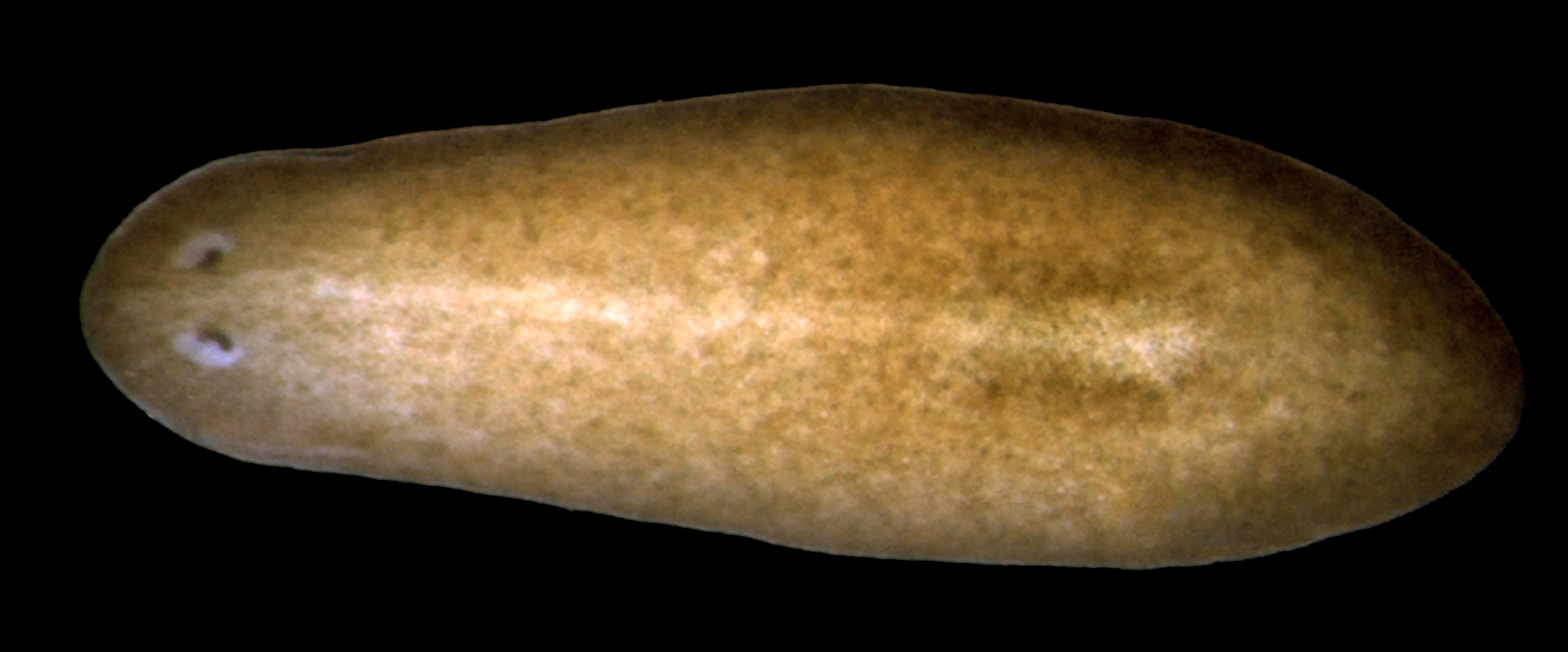
Planarians are small flatworms that live in ponds and rivers on almost every continent. They are among the most simple organisms that possess a central nervous system: behind the two cross-eyed looking eye spots is a small bundle of neurons that serves as a brain. Extending from the brain is a primitive yet effective nervous system. Planarians also have a digestive system, and, in some species, both male and female reproductive organs (sexual planarians are hermaphrodites). All of these specialized tissues can be regrown from a tiny chunk (as few as about 10,000 cells) cut out of the side of the worm. The great geneticist Thomas Morgan, before he went on to do his famous fruitfly work, discovered (in the kind of work that would be a 10 year-old boy's dream come true) that as little as 1/279th of a planarian is enough to regrow the entire body. This is an incredible feat for such a small chunk of cells - the cells have to reorient themselves, establishing anterior and posterior ends, as well as bilateral symmetry. These cells also have to reform every type of tissue in the organism. (For some fascinating pictures of a regrowing head, check out this PDF file.)
Revealing the Secrets of Regeneration
The secret to these remarkable powers are stem cells, called neoblasts, scattered throughout the organism. How these neoblasts function in regeneration has been the focus of intense research, notably in the labs of Alejandro Sanchez Alvarado at the University of Utah, and Phillip Newmark, at the University of Illinois, Urbana-Champaign. These researchers are using the latest tools of genetics, such as knocking down genes with RNAi, to identify those genes that enable these stem cells to properly rebuild complete planarian bodies. And to leverage all of the tools that modern molecular biology has to offer, the Genome Sequencing Center at Washington University is currently sequencing a planarian genome.
Researchers in Alvorado lab recently identified two important genes involved in this process, genes that just happen to be important genes in all animals, including humans. These researchers found that when they shut down a beta-catenin gene using RNAi, planarians with amputated tails would grow a new head, instead of a new tail. In fact, shutting down beta-catenin could also transform tails into heads in whole animals with no amputated parts at all. The Alvorado lab also found that a gene which antagonizes beta-catenin, called APC (the planarian version of a gene involved in human colon cancer), has the opposite effects of beta-catenin: shutting down APC results in planarians that regrow tails in the place of amputated heads. These two genes, highly conserved in all animals, thus appear to work as master switches in planarian regeneration. An important emerging theme in modern biology is that the amazingly diverse traits found among animals is not the result of new genes for each new feature; instead, this diversity arises from how a core set of genes is put to use. Planarians share the majority of their genes with us, which means that we may some day learn how planrians use their genetic toolkit, and thus be able to manipulate human genes to perform such amazing feats of regeneration. While we won't be regrowing human heads, there is a very real hope that we'll be able to regrow human nerve tissue, such as spinal cords.
Planrians in Evolution
Planarians are also remarkable examples of creatures that appear 'half-way evolved' (of course modern planarians have been evolving as much as we have): they have features that likely resemble evolutionary intermediates of complex vertebrate organs, such as eyes. Planarian eyes don't have lenses, but they do have light sensing cells hooked up to the central nervous system, as well as a curved 'optic cup' that enables planarians to gain some information about the direction of a light source. Another primitive feature of planarians are the early cell divisions of planarian embryos: in contrast with the highly ordered process seen in vertebrates, planarian embryos undergo a series of very disordered cell divisions. And yet this system of disordered embryogenesis produces perfectly good adult organisms. People often find it hard to imagine how evolution can produce complex processes or structures, such as human eyes, or the development of a human embryo. How could an eye progressively evolve? In planarians, we can see that much more primitive physiological systems, having only some of the features of their more complex human counterparts, can be perfectly functional and therefore sustained by natural selection.
For more on planarians, and some fun pictures, check out:
http://www.planarians.org/
and this cool picture.
Photo credit: Wikipedia commons (uploaded by Alejandro Sanchez), under the Creative Commons License




1 comment:
Post a Comment